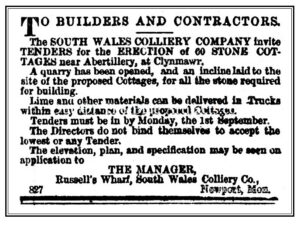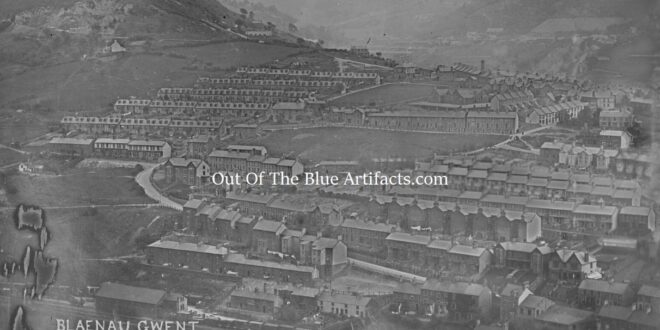Clyn-Mawr Cottages – Blaenau Gwent Rows.
In 1873 Capt. Lawrence Heyworth, the chairman of the South Wales Colliery Company purchased land from the Nantyglo & Blaina Coal Company. The land was situated close to the Glo-Byllau Farm on Old Blaina Road between Blaina and Abertillery. His intention was to open a colliery which he could have control and a vested interest, though was mainly financed by the South Wales Colliery Company.
Mr Lawrence Heyworth had an idea to have around sixty cottages built on land in the Clyn Mawr area of Abertillery (as seen top left of the main featured image above) to house part of the workmen and families of the men who would later work at his colliery. He and his wife had a keen interest in the social welfare of the people, they only wanted the best housing conditions for his workers and he became directly responsible for the layout and architecture of the cottages at Clyn Mawr.
At the same time the South Wales Colliery Company planned to build another thirteen similar cottages to add to their housing stock in the Cwmtillery area. The new houses would be built opposite the colliery on the eastern bank at Roberts Row with the cottages being of the same design as those at Clyn-Mawr. (The other houses at Cwmtillery were the older colliery company’s houses constructed under a different design).
The Rising Sun Quarry.
The initial planning consisted of the opening of a quarry upon the side of Mynydd James located behind the Rising Sun Inn, this quarry could supply the stone for the building of the cottages. The incline tram-road from the quarry came down Ty Bryn Hill, turning right down through what is now number 3 and number 4 Attlee Avenue and on down a route what is now the garages between the rows and the park. The unloading bay was close to what is now the council road-salt depot close to the bottom row.
In the summer of 1873, the quarry was opened and the incline laid down in readiness.
 The Tenders for the Cottages at Clyn Mawr.
The Tenders for the Cottages at Clyn Mawr.
On Monday 25th of August 1873, tenders were put out for the building of the cottages on the (as seen left). The start of the building of the cottages went ahead late 1873 early 1874.
The Rose Heyworth Colliery Sinking.
In January 1874 the construction of the Rose Heyworth Colliery began, the land was cleared of many trees, the area was prepared and tenders were invited for the building of the railway sidings, yard and out-buildings for the colliery, temporary wooden houses were erected close by for the initial workers, engineers and sinkers etc.
In March 1874 tenders were put out for the sinking of the Rose Heyworth Colliery, this coincided with the start of the erection of the cottages at Clyn Mawr.
The Cwmtillery Colliers Hall.
By the summer of 1874 work was well underway at Rose Heyworth Colliery, Clyn Mawr and at Cwmtillery Mr Lawrence Heyworth felt the need for a Colliers Hall (close to the feeder lake in the Cwmtillery valley), a place where the men could have social evenings, a distraction from the inns and public houses. Mr Heyworth arranged for a public subscription to be set up and he also took money from the company’s shareholders to help finance the building of the Colliers Hall in the Cwmtillery Colliery grounds.
Description of the Clyn Mawr Cottages.
The cottages were built in five rows of thirteen cottages, after the design and plans of Capt. Heyworth, Chairman of the company. The ground floor consisted of a large roomy kitchen with a paved floor, having a strong wrought iron bar grate and oven. The kitchen also had a convenient dresser and shelves as a fixture. Adjoining the kitchen were two convenient sized rooms with boarded floors – one as a sitting room and the other as a bedroom if needed. Each room had a ventilator fixed to the wall. The cottages had good bold windows, double hung. Attached to the kitchen was a pantry and a closet. The bedroom floor consisted of two large rooms with dormer lights.
Outside each cottage at the back was wash-house fitted up with a food safe, a bread oven, a boiler and a washing sink connected with a drain, in turn connected to the main sewer. Each cottage also had an enclosed walled in and paved yard. Each yard was fitted with a stench tap and a neat iron gate. The cottages had long gardens for drying clothes and for cultivation. Each cottage also had attached a shut-in coal house and a W.C. constructed on the “Dry Earth” principle according to Mr Heyworth’s system. The rent was 5s. per week and the cottages were such a high standard of living to attract the miners to the valley.
This “Dry Earth” system consisted of a cemented pit in the garden covered with an iron grid and fixed at an inclination, each tenant according to the rules of occupation was expected to throw the house ashes, which had the same effect as the earth closets. With the grid arrangement there was also a feature of economy in the screening of cinders, which the tenants could now re-use instead of throwing them away, therefore thus saving about 1 fourth in the amount of coal consumed as compared to previous consumption. This re-use in cinders also saved the area from the build-up of ugly ash tips which blighted the Welsh valleys.
The building of the cottages had been much slower than expected and the company said the reason for this was that the neighbourhood was busy with other building projects. In the September of 1874, only nineteen of the cottages were completed and an additional twenty-six ready for completion. Until this time all the industrial activity was concentrated in the Blaina, Nantyglo area with just a few levels and the tinworks at Abertillery, but by sinking the Rose Heyworth Colliery, Mr Lawrence Heyworth had opened this area up to the influx of workers to this part of Aberystruth.
The Cost of the Clyn Mawr Cottages.
In the Monmouthshire Merlin newspaper 5th of March 1875, the South Wales Colliery Company issued the outlay and costs etc of their undertakings in the both valleys, they stated the sum of £2,928 had been spent on the sixty-five cottages at Clyn Mawr and a smaller sum on the thirteen at Cwmtillery. The chairman thought an extra £4,500 would be required, though a later edition reported said the sum of £4,521. 4s. 6d. was expended on cottage accommodation which included necessary roads and all drainage costs.
The main featured image above showing the Blaenau Gwent Rows is from the Martin Ridley Collection.
Later Years.
In April 1970 the council invited tenders from builders to renovate fifty-five cottages at Blaenau Gwent Rows. In May 1970 the Gwent Gazette reported that the tender of £105,987 had been approved and work was to begin. The residents of the cottages were temporary re-housed by the council while major renovations were carried out and the top row converted to old age pensioners units and bungalows.
Points of Interest – Sometime during the 1950’s-60’s, numbers 1 and 2 cottages on the top row Blaenau Gwent were demolished through the result of subsidence and they were never replaced. The site of those demolished houses is now occupied by a newly erected stone War Memorial.
The Date Stone Query.
There is a mystery over the date stone located on the pine end of the cottage on the second row up from the bottom, it reads ” Architect Col L. Heyworth and Builder E. Phillips 1871″ the date is wrong and the style and placing of it is also in question. Adding to this it was not covered over or lost during the major renovations in the 1970’s or others since. I have seen other date stones inscribed with L. Heyworth and they have archaic Welsh inscriptions and old Gothic like carving styles. This one at Clyn Mawr looks a modern font and is in English. I can’t prove it, but strongly believe that the original stone was of the old type and located on the pine end at number 1 top row, though when those two cottages were demolished, it was ruined and a new one was chiselled, the real dates were guessed, and guessed wrongly, the same as the sinking dates of the other collieries in the area.
 Out Of The Blue Artifacts A Library of a lifetime of collecting
Out Of The Blue Artifacts A Library of a lifetime of collecting
